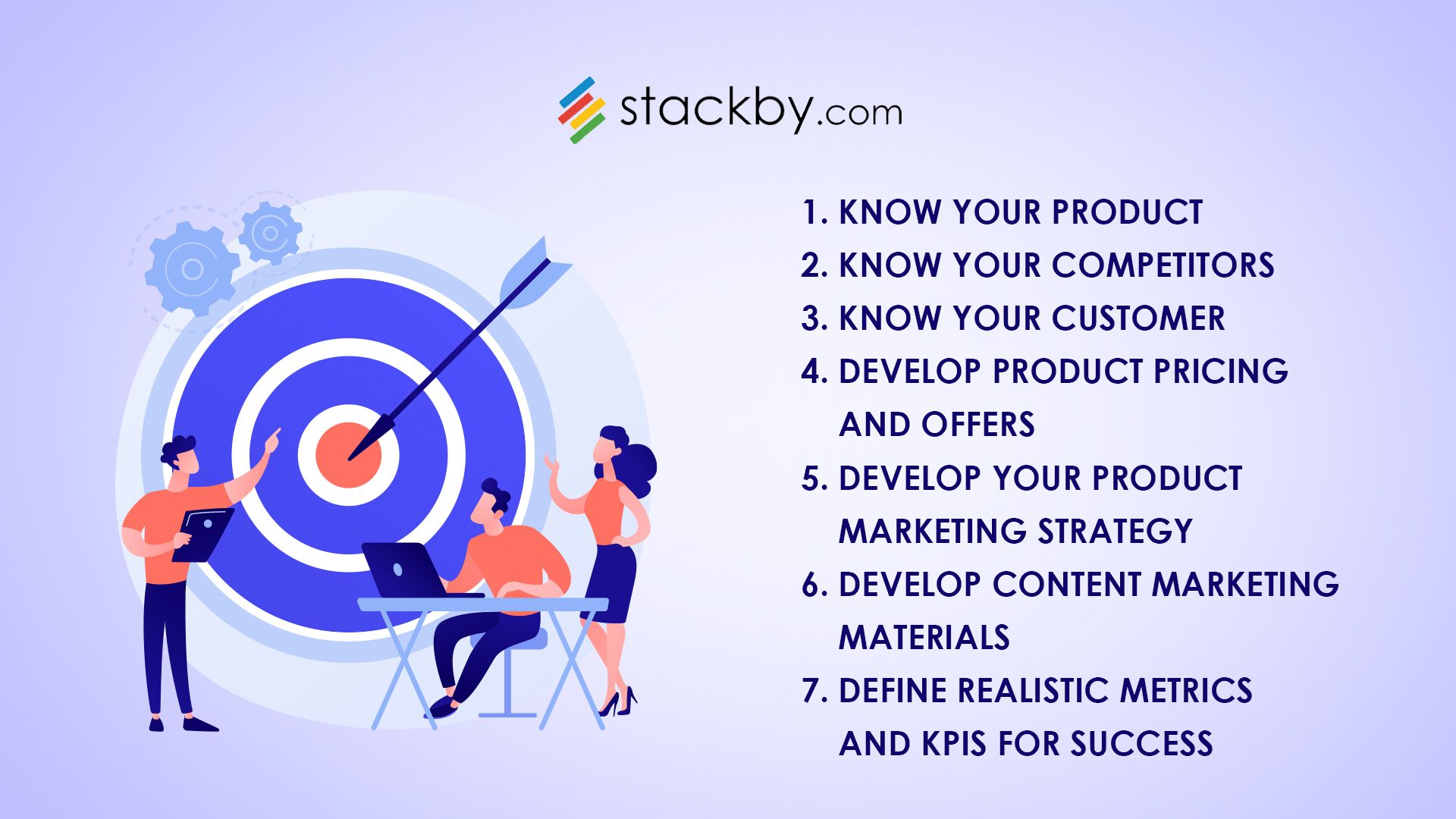Ultimate Guide to Product Marketing : How to Market a Software Product in 2026
Explore top strategies for marketing software products in 2026. Boost sales with user-focused insights and effective tactics.

In the ever-evolving digital world, marketing a software product demands a strategic approach that integrates a thorough understanding of the product, the market, and the target audience. As software solutions advance and diversify, marketing strategies must also adapt and innovate. This guide will navigate you through the crucial steps and best practices for successfully marketing your software product in 2024.
What is Product Marketing?

Product marketing is the process of bringing a product to market, promoting it, and selling it to a customer. It involves understanding the product's audience and using strategic positioning and messaging to boost revenue and demand. Unlike general marketing, product marketing focuses on driving the adoption and usage of a specific product.
50+ Use Free All Product Marketing Database Templates
Differences in Software Solution Product Marketing
Marketing software products differ significantly from marketing physical goods. Software is intangible and often requires continuous updates and customer support. Moreover, the market for software products is highly competitive and rapidly changing, necessitating agile and adaptable marketing strategies. Here are some unique aspects of software product marketing:
- Intangibility: Software cannot be seen or touched, so marketing must emphasize its benefits, features, and user experience.
- Subscription Models: Many software products are sold on a subscription basis, requiring ongoing customer engagement and retention strategies.
- Technical Complexity: Marketing must often explain complex technical details in an understandable way.
- Rapid Iteration: Software products frequently update, so marketing strategies must be flexible to accommodate new features and changes.
7 Steps of Digital Product Marketing Strategy

1. Know Your Product
Understanding your software product inside and out is the first step in creating an effective marketing strategy. This includes knowing its features, benefits, limitations, and unique selling points (USPs). A thorough product knowledge enables you to communicate its value effectively to your target audience.
2. Know Your Competitors
Conduct a competitive analysis to understand who your competitors are, what they offer, and how they market their products. Identify their strengths and weaknesses to find opportunities for differentiation. Tools like SWOT analysis (Strengths, Weaknesses, Opportunities, Threats) can be particularly useful here.
Software marketers can benchmark growth using an actionable seo analysis template for holistic competitor tracking and link profile reviews.
3. Know Your Customer
Create detailed buyer personas that represent your ideal customers. Understand their pain points, needs, and behaviors. This information helps tailor your marketing messages to resonate with your audience and address their specific challenges.
If you’re launching a product in multiple markets (or expanding to new ones), you also need to think about cultural nuances: if you’re launching in the United States, for example, hiring a US employee can provide you with detailed insight into consumer habits and preferences.
4. Develop Product Pricing and Offers
Pricing your software product correctly is crucial for its success. Consider factors like production costs, competitor pricing, and perceived value. You might also develop various pricing tiers or bundles to cater to different customer segments. Offering free trials or freemium models can also attract users and convert them into paying customers.
5. Develop Your Product Marketing Strategy
Your marketing strategy should outline the channels and tactics you will use to promote your product. This could include content marketing, social media, free email marketing campaigns, search engine optimization (SEO), pay-per-click (PPC) advertising, and more. Ensure that your strategy is cohesive and that each tactic supports your overall marketing goals.
To scale this effectively, white label marketing services can be a game changer. These services offer specialized expertise and behind-the-scenes execution, enabling you to deliver sophisticated campaigns under your brand while freeing up internal resources to focus on innovation and strategic growth.
6. Develop Content Marketing Materials
Content marketing is essential for educating your audience and demonstrating the value of your software product. Create a variety of content types, including blog posts, whitepapers, case studies, videos, and infographics. A free infographic maker can streamline this process, turning raw product data into engaging visuals that resonate with prospects. This content should address the needs and pain points of your target audience and showcase how your product can solve their problems.
7. Define Realistic Metrics and KPIs for Success
Establish key performance indicators (KPIs) to measure the success of your marketing efforts. These could include metrics like website traffic, conversion rates, customer acquisition cost (CAC), customer lifetime value (CLV), and more. Regularly review these metrics to assess the effectiveness of your strategy and make data-driven adjustments as needed.
Best Practices for Digital Product Marketing
Use Video to Show Your Product in Action
Videos are an effective way to demonstrate your software's features and benefits. They provide a visual and interactive way for potential customers to see the product in action. Create tutorial videos, product demos, and customer testimonials to build trust and engagement.
Create Interactive Elements to Engage Your Audience
Interactive content, such as quizzes, polls, and interactive infographics, can engage your audience more deeply than static content. These elements can also provide valuable insights into your audience's preferences and behaviors.
Keep an Eye on Competitor Actions
Regularly monitor your competitors' marketing activities to stay informed about industry trends and emerging tactics. Use tools like Google Alerts, SEMrush, or Ahrefs to track competitors' content, keywords, and backlinks.
Product Marketing vs. Product Management

While product marketing and product management are closely related, they serve distinct but complementary functions within an organization. Understanding the differences between these roles is crucial for effectively aligning efforts and ensuring the success of your software product.
Product Marketing
Product marketing is primarily concerned with bringing the product to market and driving demand. The responsibilities of product marketing encompass a range of activities that ensure the product resonates with its target audience and stands out in the competitive landscape. Here are some key aspects:
- Market Research: Product marketers conduct thorough market research to understand customer needs, preferences, and pain points. This research informs product positioning and messaging strategies.
- Messaging and Positioning: Crafting compelling messages that highlight the product's unique value proposition is a core task of product marketing. Effective messaging and positioning help differentiate the product from competitors and communicate its benefits clearly to potential customers.
- Sales Enablement: Product marketers create sales tools, presentations, and training materials to empower the sales team with the knowledge and resources they need to effectively sell the product. This includes developing case studies, product demos, and competitive analysis.
- Go-to-Market Strategy: Developing and executing a go-to-market strategy (GTM) is a critical responsibility of product marketing. This strategy outlines the launch plan, marketing tactics, and distribution channels to ensure the product reaches its target audience and achieves its sales goals.
Product Management
Product management, on the other hand, focuses on developing the product itself. Product managers are responsible for defining the product's vision, strategy, and roadmap, ensuring that the product meets market demands and achieves business objectives. Key responsibilities include:
- Defining Product Requirements: Product managers gather and prioritize customer feedback, market trends, and business needs to define product requirements. They create detailed product specifications and user stories that guide the development process.
- Managing the Development Process: Product managers work closely with cross-functional teams, including engineering, design, and QA, to ensure the product is developed on time and within budget. They oversee the development lifecycle, from concept to release, and ensure that each stage meets the defined requirements.
- Overseeing the Product Lifecycle: Product managers are responsible for the entire lifecycle of the product, from initial development to end-of-life. This includes ongoing product improvements, feature updates, and managing the product's performance in the market.
- Strategic Planning: Product managers develop long-term strategies for the product, aligning it with the overall business goals and market opportunities. They continuously assess the product's performance, gather user feedback, and make data-driven decisions to enhance its value.
30+ Free Product Database Templates to Manage Your Database
Collaboration Between Product Marketing and Product Management
Effective collaboration between product marketing and product management is essential for the success of a software product. While product managers focus on building the right product, product marketers ensure that the product reaches the right audience with the right message. Here are some ways they can work together:
- Regular Communication: Frequent and open communication between product marketing and product management teams helps align their efforts and ensures that both teams are working towards common goals.
- Shared Goals and Metrics: Establishing shared goals and metrics allows both teams to measure success and make informed decisions. For example, product adoption rates, customer satisfaction scores, and revenue targets can be common metrics.
- Cross-Functional Meetings: Regular cross-functional meetings provide opportunities for product managers and product marketers to discuss progress, share insights, and address any challenges. These meetings foster collaboration and ensure alignment.
- Customer Feedback: Both teams should collaborate on gathering and analyzing customer feedback. Product marketers can provide insights from market research and customer interactions, while product managers can use this feedback to inform product development.
FAQs: Digital Product Marketing Launch
Q1: Why is Product Marketing Important?
Product marketing is essential because it bridges the gap between the product and the market. It ensures that the product meets the needs of the target audience and that the audience understands the product's value.
Q2: What is Product Positioning in Marketing?
Product positioning involves creating a unique, advantageous image of the product in the customer's mind. It differentiates the product from competitors and highlights its most compelling benefits.
Q3: How is the Marketing Concept Different from the Product Concept?
The marketing concept focuses on meeting customer needs and delivering value through coordinated marketing efforts. The product concept, on the other hand, focuses on continuous product improvement and innovation to meet customer expectations.
Q4: Which Marketing Function Involves Creating the Correct Product Mix for a Business?
Creating the correct product mix involves several functions, including:
- Market Research: Understanding customer needs and preferences.
- Product Development: Designing and creating products that meet those needs.
- Pricing Strategy: Setting prices that reflect the product's value and competitive positioning.
- Promotion: Communicating the product's benefits to the target audience.
- Distribution: Ensuring the product is available where and when customers want it.
Conclusion: Start Marketing Your Digital Product with Confidence
Marketing a software product in 2024 requires a well-thought-out strategy that combines in-depth product knowledge, competitive analysis, customer insights, and effective use of various marketing channels. By following the steps and best practices outlined in this guide, you can create a successful product marketing strategy that drives demand and growth for your software product. Embrace the power of digital marketing tools and techniques to reach your target audience and achieve your business goals.

This article was originally published in July 2022 by Stackby Content Team. The most recent update was in July 2025.

![Step by Step Guide on How to Build Forms in a Database [2026]](/blog/content/images/2022/03/form-database-blog.png)


